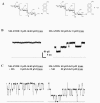Nanopores: maltoporin channel as a sensor for maltodextrin and lambda-phage
- PMID: 15743521
- PMCID: PMC555588
- DOI: 10.1186/1477-3155-3-3
Nanopores: maltoporin channel as a sensor for maltodextrin and lambda-phage
Abstract
BACKGROUND: To harvest nutrition from the outside bacteria e.g. E. coli developed in the outer cell wall a number of sophisticated channels called porins. One of them, maltoporin, is a passive specific channel for the maltodextrin uptake. This channel was also named LamB as the bacterial virus phage Lambda mis-uses this channel to recognise the bacteria. The first step is a reversible binding followed after a lag phase by DNA injection. To date little is known about the binding capacity and less on the DNA injection mechanism. To elucidate the mechanism and to show the sensitivity of our method we reconstituted maltoporin in planar lipid membranes. Application of an external transmembrane electric field causes an ion current across the channel. Maltoporin channel diameter is around a few Angstroem. At this size the ion current is extremely sensitive to any modification of the channels surface. Protein conformational changes, substrate binding etc will cause fluctuations reflecting the molecular interactions with the channel wall. The recent improvement in ion current fluctuation analysis allows now studying the interaction of solutes with the channel on a single molecular level. RESULTS: We could demonstrate the asymmetry of the bacterial phage Lambda binding to its natural receptor maltoporin. CONCLUSION: We suggest that this type of measurement can be used as a new type of biosensors.
Figures



Similar articles
-
Interaction of bacteriophage lambda with its cell surface receptor: an in vitro study of binding of the viral tail protein gpJ to LamB (Maltoporin).Biochemistry. 2006 Feb 28;45(8):2708-20. doi: 10.1021/bi051800v. Biochemistry. 2006. PMID: 16489764
-
Docking of a single phage lambda to its membrane receptor maltoporin as a time-resolved event.J Mol Biol. 2006 Jun 23;359(5):1447-55. doi: 10.1016/j.jmb.2006.04.034. Epub 2006 Apr 27. J Mol Biol. 2006. PMID: 16697410
-
Channel architecture in maltoporin: dominance studies with lamB mutations influencing maltodextrin binding provide evidence for independent selectivity filters in each subunit.J Bacteriol. 1989 Feb;171(2):855-61. doi: 10.1128/jb.171.2.855-861.1989. J Bacteriol. 1989. PMID: 2521623 Free PMC article.
-
General and specific porins from bacterial outer membranes.J Struct Biol. 1998;121(2):101-9. doi: 10.1006/jsbi.1997.3946. J Struct Biol. 1998. PMID: 9615433 Review.
-
Mechanisms of cellular synchronization in the vascular wall. Mechanisms of vasomotion.Dan Med Bull. 2010 Oct;57(10):B4191. Dan Med Bull. 2010. PMID: 21040688 Review.
Cited by
-
Mechanisms involved in governing adherence of Vibrio cholerae to granular starch.Appl Environ Microbiol. 2010 Feb;76(4):1034-43. doi: 10.1128/AEM.01533-09. Epub 2009 Dec 18. Appl Environ Microbiol. 2010. PMID: 20023099 Free PMC article.
-
Synthesis, radiolabeling, and biological evaluation of methyl 6-deoxy-6-[18F]fluoro-4-thio-α-d-maltotrioside as a positron emission tomography bacterial imaging agent.RSC Adv. 2025 Mar 21;15(11):8809-8829. doi: 10.1039/d5ra00693g. eCollection 2025 Mar 17. RSC Adv. 2025. PMID: 40124918 Free PMC article.
-
Nanopore-based glycan sequencing: state of the art and future prospects.Chem Sci. 2024 Apr 3;15(17):6229-6243. doi: 10.1039/d4sc01466a. eCollection 2024 May 1. Chem Sci. 2024. PMID: 38699252 Free PMC article. Review.
-
Redesign of a plugged beta-barrel membrane protein.J Biol Chem. 2011 Mar 11;286(10):8000-8013. doi: 10.1074/jbc.M110.197723. Epub 2010 Dec 28. J Biol Chem. 2011. PMID: 21189254 Free PMC article.
-
Using ion channel-forming peptides to quantify protein-ligand interactions.J Am Chem Soc. 2008 Jan 30;130(4):1453-65. doi: 10.1021/ja077555f. Epub 2008 Jan 8. J Am Chem Soc. 2008. PMID: 18179217 Free PMC article.
References
LinkOut - more resources
Full Text Sources
Other Literature Sources

